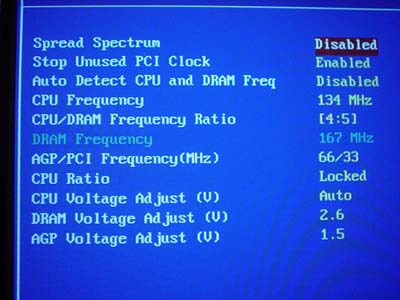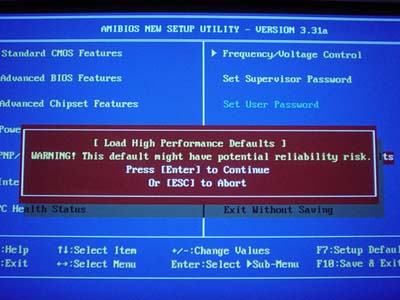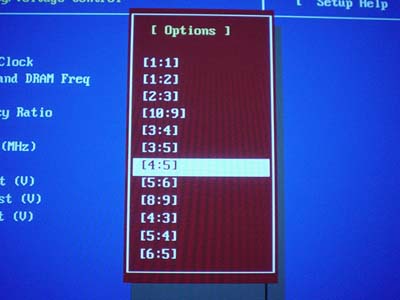MSI 655 Max: BIOS and Overclocking
MSI chooses a fairly popular BIOS, dubbed AMI BIOS. While most prefer Award BIOSes, we have nothing against the AMI BIOS setup.
You can find hardware monitoring in the PC Health section of the 655 Max BIOS. There are several good readings present in this section, which include CPU and System temperature, CPU and System fan speed, Vcore, PSU readings (all rails), battery voltage and an option for enabling or disabling CPU Warning Beep (when the CPU temperature gets too high). All in all this is a very basic PC Health section, quite similar to MSI's K7N2-L (nForce2) actually.
The 655 Max's Advanced Chipset Features section doesn't contain as many options as most tweaker-friendly BIOSes usually do. There aren't any Active to Precharge, Precharge to Active or Active to CMD options as is almost always the case in enthusiast BIOSes. However, CAS Latency, DRAM timing mode and two other 1T/2T options are available. Even though CAS Latency is available as low as 2.0, we were unable to boot into Windows XP with our Corsair XMS memory set to a CL of 2.0. This held true with other types of memory as well, including Kingston, Mushkin and Crucial modules. However, the good thing about this Advanced Chipset Features section was that we were able to set DRAM timing mode to Ultra, which is very fast. DRAM timing mode options start from Safe mode and go to Normal, Fast, Turbo and finally Ultra mode. We were able to successfully operate the 655 Max with CL set to 2.5 and DRAM timing mode set to Ultra, which yielded some very impressive performance numbers.
There is a section in the 655 Max BIOS called "Frequency/Voltage Control", which allows a very generous amount of tweaking options. In this section you're allowed to adjust FSB, CPU/DRAM ratios (i.e. DRAM frequency), AGP and PCI frequency, CPU Vcore, VDIMM and VAGP. This section is vital to those users looking to squeeze as much performance as possible from their system.
Another interesting option that MSI has continually included in their BIOSes is their "High Performance Default" setting. MSI makes sure the user knows that loading "High Performance Defaults" may cause system instability. However, we were able to load "High Performance Default" settings and reliably run all our benchmarks and stress tests. There is a small performance increase if you load the "High Performance" setting versus just loading the "Optimal Defaults" in the BIOS. Therefore we see no downside in doing so, though if you experiences general stability issues you may want to start out by reloading the "Optimal Defaults" in the 655 Max BIOS to troubleshoot your system.
Front Side Bus options are available up to 250MHz in 1MHz increments in the 655 Max BIOS. This is more than enough for even the most hardcore overclockers out there. Even with liquid nitrogen you probably wouldn't be able to reach 250MHz FSB, so we think this FSB should be fine.
MSI allows very flexible memory ratios in the 655 Max BIOS that allow for dual channel DDR400 operation. There are a total of twelve different memory ratios present. Some of the more notable ones include 1:1 (DDR266), 4:5 (DDR333) and 2:3 (DDR400) assuming you're using a 533MHz FSB Pentium 4 processor.
The Vcore adjustments present in the 655 Max BIOS are very weak, even for casual users. The max attainable Vcore is just 1.60V. But what makes this Vcore even worse is the fact that stock Vcore runs at an actual 1.44V on average (as read by the BIOS' hardware monitor). Therefore, in reality, you won't be able to operate your P4 processor at anything higher than about 1.54V. This is certainly disappointing for serious overclockers, but might not be too bad once you consider how well this motherboard overclocks (as you will soon discover in the coming paragraphs).
VDIMM adjustments are available in the 655 Max BIOS all the way up to 2.8V in 0.1V increments. This is plenty for most users, as memory overvolting doesn't usually yield a significantly better memory overclock. We suggest you set your VDIMM no higher than 2.8V, and even that voltage is pushing the envelope a bit too much.
There have been a lot of SiS motherboards we've tested in the past that lacked an AGP/PCI lock in the BIOS. Thankfully, this is not true of MSI's 655 Max. It is clearly visible in the 655 Max BIOS that an AGP/PCI lock has been fully implemented, and in fact is adjustable up to 80MHz/40MHz.
Having performed extensive FSB overclocking testing on numerous SiS chipset-based motherboards in the past, we weren't expecting anything stellar from MSI's 655 Max motherboard. I think many readers will be surprised to learn our results. We used the following setup for FSB overclocking on the MSI 655 Max:
| Front
Side Bus Overclocking Testbed |
|
|
Processor: |
Pentium
4 2.26GHz |
|
CPU
Vcore: |
1.5V
(acutal) |
|
Cooling: |
Intel
Retail HSF & Thermal Pad |
|
Power
Supply: |
Enermax
300W |
Amazingly enough, we were able to reach a FSB overclock of 165MHz with this very conservative setup. This is by far the highest FSB overclock we've seen from any SiS chipset-based motherboard before (the previous high being 152MHz FSB on ECS's L4S8A). In fact, this overclock rivals boards based on Intel's 845PE chipset. That is, the highest FSB overclock we've been able to achieve out of any P4 motherboard has been 166MHz FSB on Albatron's PX845PEV Pro (845PE). What's even more impressive is that the MSI 655 Max was able to reach 168MHz FSB fairly easily and was, for the most part, quite stable. However, we experienced a couple device failures (keyboard and mouse) at 168MHz FSB that wasn't remedied until we brought it down to 165MHz FSB. Overall we're thrilled at these overclocking results.















1 Comments
View All Comments
gustavlasko - Friday, April 16, 2004 - link
Things must have changed since this article is written and now. I myself had to RMA a board that I bought off ebay with MSI. It was a painless process, altough it did take about a month altogether until the board was back, but I had no problems whatsoever with their customer support.